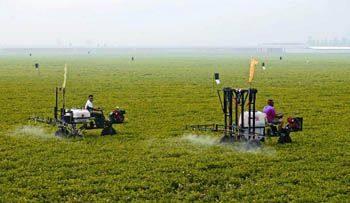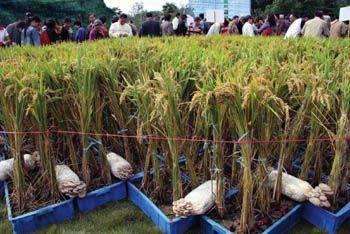Sci-tech progress will propel China’s agriculture
LI YUAN

CHINAs grain output hit 571 million tons in 2011 – 24.7 billion kilograms more than the previous year, so achieving eight consecutive years of sustained grain production growth. The country has also set a new record by maintaining more than 500 million tons of annual grain production over the past five years.
There is, however, an old Chinese saying, “If people are to eat every day, crops must be planted every year.” Both natural and human factors have created uncertainties in Chinas grain production. Maintaining grain security is a constant topic in a country with such a large population.
Under the challenges of abnormal climate, rising costs and farmers waning enthusiasm for growing crops, what does the future hold for Chinas agriculture? To find out, China Today interviewed Chen Xiwen, deputy director of the Central Rural Work Leading Group and director of its general office.


Develop Agriculture T hrough science and Technology
“There is no doubt that agricultural safety is one of the paramount issues in a country with a population of 1.3 billion,” Chen began. “Expanding grain output by relying on higher material input is no longer feasible. We must instead look to science and technology and make optimum use of our available resources. Promoting innovation in agricultural science and technology is the main theme of this years No.1 document jointly released by the Communist Party of China Central Committee and the State Council.”
The No.1 central document, published each year since 2004, highlights the Chinese governments vigilance on rural issues. The 2012 document emphasizes the crucial role of agricultural technology.
Chen acknowledges the huge gap between China and developed countries in agricultural infrastructure and technology.“Barely 50 percent of total arable land in China is irrigated, which means that almost half of the countrys harvests depend on suitable weather conditions. As science and technology contributed 53.5 percent to agricultural growth last year, China has clearly made great progress in this respect, but still lags far behind developed countries.”
As far back as 1989, the Chinese government issued a document promoting proven agricultural science and technology applications, and pinpointing stable growth of grain production as the foundation for national economic development. It stated that the development of agriculture was supported by policies and investment, as well as science and technology, but the latter was the ultimate solution.
Two decades later, shortages of arable land and water impede Chinas agriculture, and there is growing pressure to ensure protection of the ecological environment. Since China joined the WTO, there has been rising demand on the international market for high-quality, green farm products. In Chens view, the traditional production mode that relies on resource consumption is no longer tenable. Other challenges to contend with include shortages of skilled farm workers and soaring labor costs. All of these factors signify that China must now employ science and technology to maintain sustainable agricultural development.
At the Central Rural Work Conference at the end of 2011, the Chinese government set its grain production goal for 2012 at more than 525 million tons, a figure lower than that for 2011.
“The Chinese government is clearly cognizant that China has a long way to go before it can meet international advanced standards of modern agriculture. Innovation in science and technology is the only way of ensuring long-term, healthy agricultural development,” Chen said.
“Professional Farmers” needed
“If farmers have difficulties in selling their products, why should anyone want to grow crops?”
“Most farmers working in the fields are now in their 60s and 70s. Who will tend the land in ten years time?”
These are common, entirely reasonable concerns. Although farmers net income has increased faster than that of urban residents in recent years, heavy workloads and low earnings nevertheless force many young rural laborers to leave farm work for jobs in cities.
Chen explained the recent rapid increase in farmers net earnings, whereby in addition to selling farm products they receive government farming subsidies, and some also find jobs in cities. But they nonetheless earn around a third of what urban residents do. In 2011, the per capita net income of farmers was RMB 6,977 as compared to urban residents per capita disposable income of RMB 21,810. There has thus been scant narrowing of the huge urbanrural income gap.
Chen further pointed out that the low purchasing power of farmers, who represent half of the countrys population, inhibits the potential of domestic demand.
“Statistics show that 900 million of Chinas population live in counties, towns and villages, among whom 670 million are farmers. But this 900 million contributed just 32 percent to the countrys consumer market last year. In other words, two-thirds of the population consumed only one-third of its products. The rural market thus remains untapped. To drive Chinas economy through domestic demand, therefore, we have to make concerted efforts to raise farmersincomes.” Chen believes that the government should foster more “professional farmers” as well as stepping up investment if the country is to achieve modern agriculture.
“Talented workers are crucial. More rural laborers should be trained to become ‘professional farmers who are conversant with agricultural technologies and also engage in large-scale agricultural production, such as running their own farms.” The experience of developed countries shows beyond doubt that cultivating professional farmers is the key to promoting agricultural development.
There are indeed professional farmers in China who have built up professional, standardized and intensive production bases. One instance is that of farmers in suburban Beijing who have made their farms tourist sites where visitors can spend weekends picking fruit and enjoying rural life. Such farmers often earn an annual income of hundreds of thousand yuan, enough to encourage younger rural inhabitants to start their own businesses on home ground rather than finding work in cities.

Only a handful of enterprising rural residents, however, have achieved this level of success. To encourage the younger generation of farmers to maintain and develop their parentsfarms, the government formulates policy support in terms of tax, finance and credit.
Promote steady Urbanization
Chinas urban population now stands at 51.27 percent of the total, so exceeding that in rural areas for the first time in history, according to 2011 National Bureau of Statistics data. This implies a historic change in the countrys social structure.
Bearing in mind that the transfer of surplus rural laborers is a major goal as regards developing small towns and cities, Chen sees the market as a powerful mechanism for promoting urbanization.
“I never worry about labor shortages in rural areas. The issue on that score is limited arable land rather than labor. Urbanization will channel a proportion of rural workers into cities, but wont cause any shortage of labor force. The emphasis should be on improving the quality of rural workers as a foundation for developing modern agriculture and building a socialist new countryside.”
Chen deplores property developers use of urbanization as an excuse to grab farmers land at low cost or even for free. “We should not sacrifice farmers interests to urbanization, but insist on industrial development that stimulates coordination of both rural and urban development.”
The 2012 government work report emphasizes farmersrights to the land they contract to work on, to the land on which their houses are built and to the proceeds of collective projects, all under the legally conferred umbrella of inviolable property rights.
“All reform and innovation should protect farmers interests and respect their will. They deserve a share in the fruits of reform and opening-up. If farmers find stable jobs, buy their own apartments and pay social security over a set period in urban areas, they should have the same entitlements as permanent urban residents to childrens education, health care and social security. Cities should treat qualified migrant workers as registered residents based on the level of local economic development and extent of local resources,” Chen said.
Chen also emphasized the need to develop rural areas to improve the living conditions of rural residents.
“Urbanization remains a powerful engine for Chinas sustained growth in the long term. But failing to give migrant laborers urban resident status will curb economic growth and also undermine social stability.”
On the matter of whether or not urbanization will affect grain security, and the risk of arable land shrinking to below the Chinese governments “red line” of 1.8 billion mu (120 million hectares), Chen said, “The past few years have witnessed the most rapid loss of arable land in Chinas history. Our per capita arable land now stands at 1.4 mu (0.093 hectares), only 40 percent of the world average. The inestimable value of arable land to Chinas long-term development is hence obvious.”Chen concluded by referring to statistics that show the country is dangerously close to its “red line.” He believes there should be stricter measures to protect arable land and guarantee efficient land use.

